主谓一致之意义一致原则
- 格式:docx
- 大小:11.02 KB
- 文档页数:4
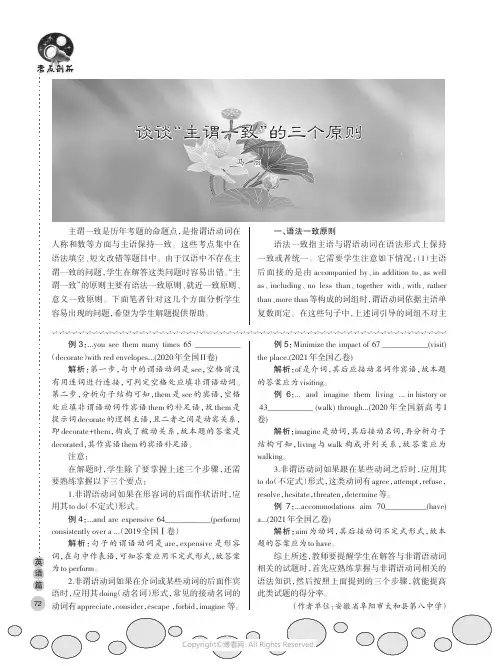
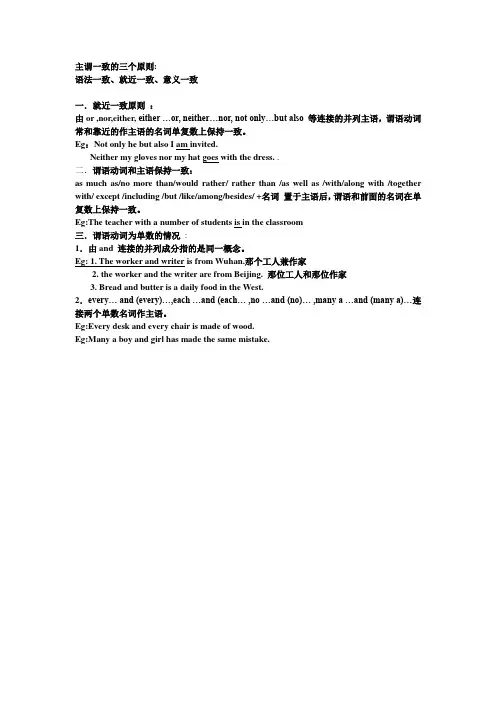
主谓一致的三个原则:语法一致、就近一致、意义一致一.就近一致原则:由or ,nor,either, either …or, neither…nor, not only…but also 等连接的并列主语,谓语动词常和靠近的作主语的名词单复数上保持一致。
Eg:Not only he but also I am invited.Neither my gloves nor my hat goes with the dress. .二.谓语动词和主语保持一致:as much as/no more than/would rather/ rather than /as well as /with/along with /together with/ except /including /but /like/among/besides/ +名词置于主语后,谓语和前面的名词在单复数上保持一致。
Eg:The teacher with a number of students is in the classroom三.谓语动词为单数的情况:1.由and 连接的并列成分指的是同一概念。
Eg: 1. The worker and writer is from Wuhan.那个工人兼作家2. the worker and the writer are from Beijing. 那位工人和那位作家3. Bread and butter is a daily food in the West.2.every… and (every)…,each …and (each… ,no …and (no)… ,many a …and (many a)…连接两个单数名词作主语。
Eg:Every desk and every chair is made of wood.Eg:Many a boy and girl has made the same mistake.。
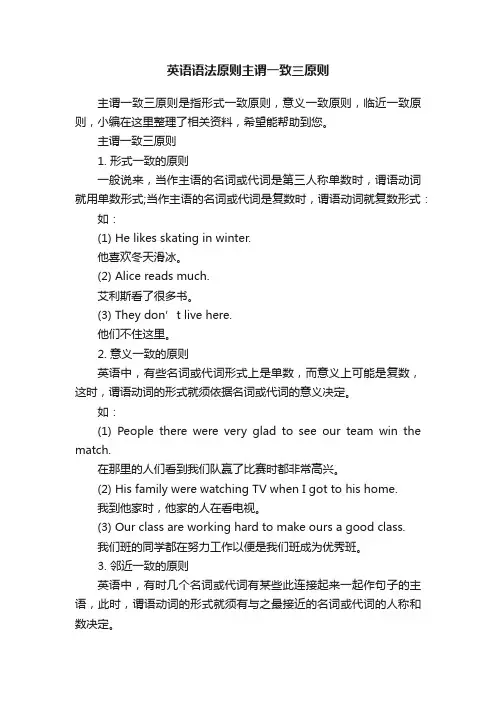
英语语法原则主谓一致三原则主谓一致三原则是指形式一致原则,意义一致原则,临近一致原则,小编在这里整理了相关资料,希望能帮助到您。
主谓一致三原则1. 形式一致的原则一般说来,当作主语的名词或代词是第三人称单数时,谓语动词就用单数形式;当作主语的名词或代词是复数时,谓语动词就复数形式:如:(1) He likes skating in winter.他喜欢冬天滑冰。
(2) Alice reads much.艾利斯看了很多书。
(3) They don’t live here.他们不住这里。
2. 意义一致的原则英语中,有些名词或代词形式上是单数,而意义上可能是复数,这时,谓语动词的形式就须依据名词或代词的意义决定。
如:(1) People there were very glad to see our team win the match.在那里的人们看到我们队赢了比赛时都非常高兴。
(2) His family were watching TV when I got to his home.我到他家时,他家的人在看电视。
(3) Our class are working hard to make ours a good class.我们班的同学都在努力工作以便是我们班成为优秀班。
3. 邻近一致的原则英语中,有时几个名词或代词有某些此连接起来一起作句子的主语,此时,谓语动词的形式就须有与之最接近的名词或代词的人称和数决定。
如:(1) There is a desk and five chairs in his room.他房间里有一张办公桌和五把椅子。
(2) There are five chairs and a desk in his room.他房间里有五把椅子和一张办公桌。
(3) Either you or Li Lei is going to be sent there.要么是你要么是李蕾将被派到那里去。
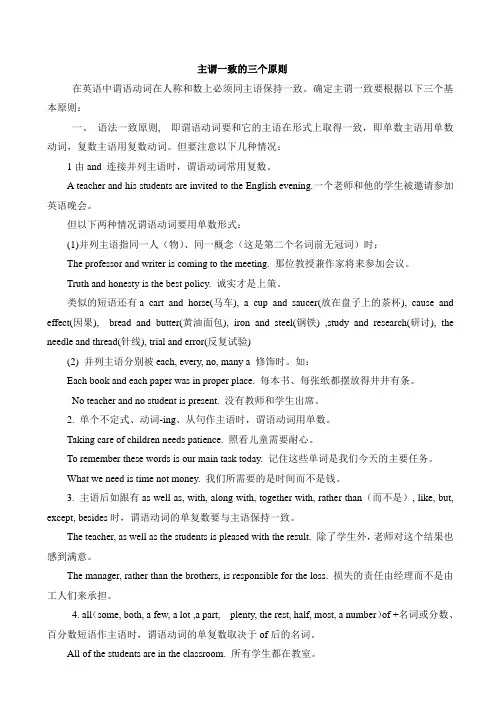
主谓一致的三个原则在英语中谓语动词在人称和数上必须同主语保持一致。
确定主谓一致要根据以下三个基本原则:一、语法一致原则, 即谓语动词要和它的主语在形式上取得一致,即单数主语用单数动词,复数主语用复数动词。
但要注意以下几种情况:1由and 连接并列主语时,谓语动词常用复数。
A teacher and his students are invited to the English evening.一个老师和他的学生被邀请参加英语晚会。
但以下两种情况谓语动词要用单数形式:(1)并列主语指同一人(物)、同一概念(这是第二个名词前无冠词)时;The professor and writer is coming to the meeting. 那位教授兼作家将来参加会议。
Truth and honesty is the best policy. 诚实才是上策。
类似的短语还有a cart and horse(马车), a cup and saucer(放在盘子上的茶杯), cause and effect(因果), bread and butter(黄油面包), iron and steel(钢铁) ,study and research(研讨), the needle and thread(针线), trial and error(反复试验)(2) 并列主语分别被each, every, no, many a 修饰时。
如:Each book and each paper was in proper place. 每本书、每张纸都摆放得井井有条。
No teacher and no student is present. 没有教师和学生出席。
2. 单个不定式、动词-ing、从句作主语时,谓语动词用单数。
Taking care of children needs patience. 照看儿童需要耐心。
To remember these words is our main task today. 记住这些单词是我们今天的主要任务。
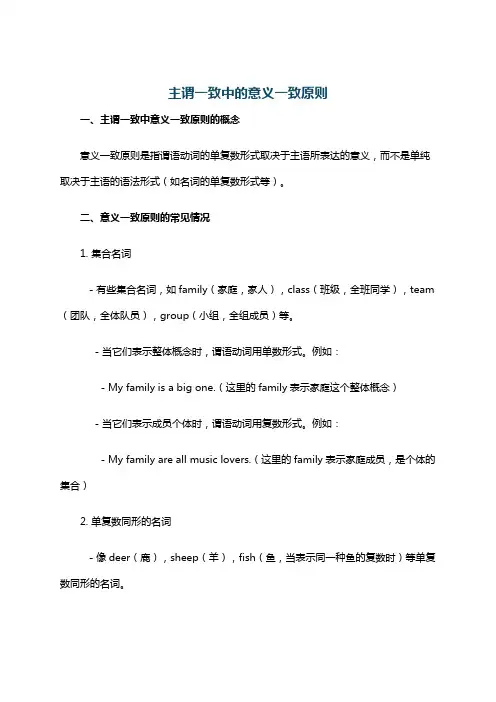
主谓一致中的意义一致原则一、主谓一致中意义一致原则的概念意义一致原则是指谓语动词的单复数形式取决于主语所表达的意义,而不是单纯取决于主语的语法形式(如名词的单复数形式等)。
二、意义一致原则的常见情况1. 集合名词- 有些集合名词,如family(家庭,家人),class(班级,全班同学),team (团队,全体队员),group(小组,全组成员)等。
- 当它们表示整体概念时,谓语动词用单数形式。
例如:- My family is a big one.(这里的family表示家庭这个整体概念)- 当它们表示成员个体时,谓语动词用复数形式。
例如:- My family are all music lovers.(这里的family表示家庭成员,是个体的集合)2. 单复数同形的名词- 像deer(鹿),sheep(羊),fish(鱼,当表示同一种鱼的复数时)等单复数同形的名词。
- 如果这类名词前有a/an或者表示单数概念的限定词时,谓语动词用单数;如果表示复数概念(如数量大于1或者有表示复数的限定词等),谓语动词用复数。
例如:- A sheep is eating grass on the hill.- There are some sheep in the field.3. 以 -s结尾但意义为单数的名词- 一些学科名词,如mathematics(数学),physics(物理),politics(政治)等,虽然以 -s结尾,但表示的是单数意义,谓语动词用单数形式。
例如: - Mathematics is not an easy subject for some students.- 还有一些疾病名称,如measles(麻疹),mumps(腮腺炎)等,谓语动词也用单数形式。
例如:- Measles is a kind of infectious disease.4. 表示时间、距离、重量、金额等复数形式的名词作主语时- 如果将这些复数形式的名词看作一个整体概念,谓语动词用单数形式。
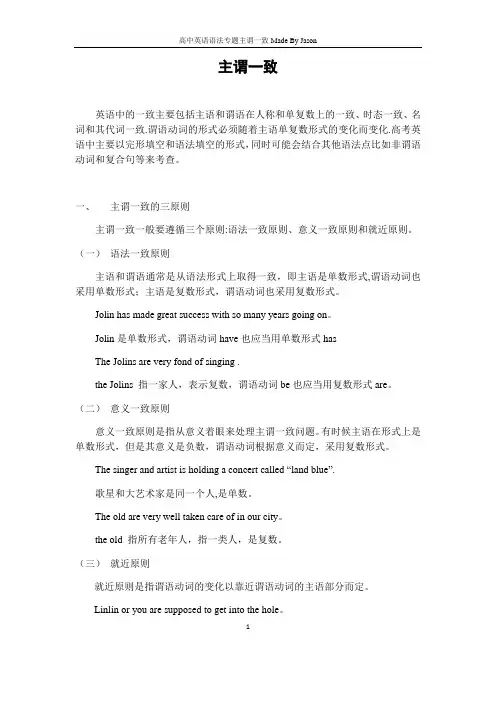
主谓一致英语中的一致主要包括主语和谓语在人称和单复数上的一致、时态一致、名词和其代词一致.谓语动词的形式必须随着主语单复数形式的变化而变化.高考英语中主要以完形填空和语法填空的形式,同时可能会结合其他语法点比如非谓语动词和复合句等来考查。
一、主谓一致的三原则主谓一致一般要遵循三个原则:语法一致原则、意义一致原则和就近原则。
(一)语法一致原则主语和谓语通常是从语法形式上取得一致,即主语是单数形式,谓语动词也采用单数形式;主语是复数形式,谓语动词也采用复数形式。
Jolin has made great success with so many years going on。
Jolin是单数形式,谓语动词have也应当用单数形式hasThe Jolins are very fond of singing .the Jolins 指一家人,表示复数,谓语动词be也应当用复数形式are。
(二)意义一致原则意义一致原则是指从意义着眼来处理主谓一致问题。
有时候主语在形式上是单数形式,但是其意义是负数,谓语动词根据意义而定,采用复数形式。
The singer and artist is holding a concert called “land blue”.歌星和大艺术家是同一个人,是单数。
The old are very well taken care of in our city。
the old 指所有老年人,指一类人,是复数。
(三)就近原则就近原则是指谓语动词的变化以靠近谓语动词的主语部分而定。
Linlin or you are supposed to get into the hole。
1You是最靠近谓语动词的主语部分,因此be动词应当用复数形式的are。
二、主谓一致的详细讲解(一)代词作主语1.不定代词either,neither, each, one,the other,another以及复合不定代词someone,somebody等作主语,谓语动词用单数。
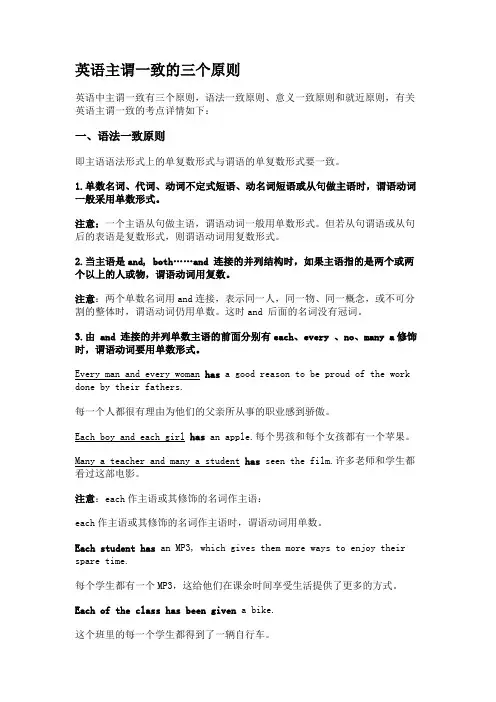
英语主谓一致的三个原则英语中主谓一致有三个原则,语法一致原则、意义一致原则和就近原则,有关英语主谓一致的考点详情如下:一、语法一致原则即主语语法形式上的单复数形式与谓语的单复数形式要一致。
1.单数名词、代词、动词不定式短语、动名词短语或从句做主语时,谓语动词一般采用单数形式。
注意:一个主语从句做主语,谓语动词一般用单数形式。
但若从句谓语或从句后的表语是复数形式,则谓语动词用复数形式。
2.当主语是and, both……and 连接的并列结构时,如果主语指的是两个或两个以上的人或物,谓语动词用复数。
注意:两个单数名词用and连接,表示同一人,同一物、同一概念,或不可分割的整体时,谓语动词仍用单数。
这时and 后面的名词没有冠词。
3.由 and 连接的并列单数主语的前面分别有each、every 、no、many a修饰时,谓语动词要用单数形式。
Every man and every woman has a good reason to be proud of the work done by their fathers.每一个人都很有理由为他们的父亲所从事的职业感到骄傲。
Each boy and each girl has an apple.每个男孩和每个女孩都有一个苹果。
Many a teacher and many a student has seen the film.许多老师和学生都看过这部电影。
注意:each作主语或其修饰的名词作主语:each作主语或其修饰的名词作主语时,谓语动词用单数。
Each student has an MP3, which gives them more ways to enjoy their spare time.每个学生都有一个MP3,这给他们在课余时间享受生活提供了更多的方式。
Each of the class has been given a bike.这个班里的每一个学生都得到了一辆自行车。


主谓一致的基本原则 Company number:【WTUT-WT88Y-W8BBGB-BWYTT-19998】主谓一致的基本原则主谓一致有以下三条原则:1)语法一致原则,即在语法形式上取得一致。
例如,主语是单数形式,谓语动词也采取单数形式;主语是复数形式,谓语动词也采取复数形式。
例如:The students are very young.This picture looks beautiful.2)意义一致原则,即从意义着眼处理一致关系。
例如,主语形式虽是单数但意义是复数,谓语动词也采取复数形式;而有些主语形式虽是复数但意义上看作单数,谓语动词也采取单数形式。
people in that country are fighting for independence.crowd deeply respect their leader.?years in a strange land seems a long time.3)就近原则,即谓语动词的单数或复数形式取决于最靠近它的词语。
例如:Neither he nor I am going to see the film tonight because we are busy.Either ..or …2.主谓一致的用法根据以上三条原则,主谓一致有如下用法:1)下列结构作主语,谓语动词一般用单数形式a.表示时间、重量、长度、价值的名词作主语,谓语动词通常用单数形式。
例如:hundred miles is a long distance.dollars is a high price for that book.b.由anyone,anything,anybody,no one,nothing,everyone,everybody,everything,someone,somebody,each,either,neither等不定代词作主语,谓语动词使用单数形式。
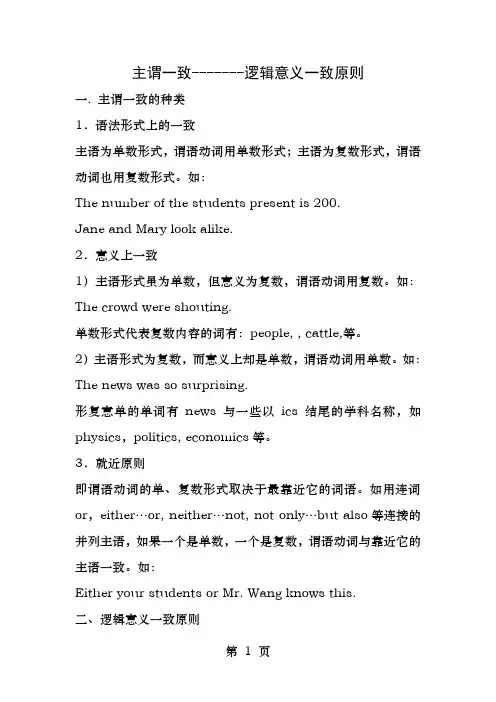
主谓一致-------逻辑意义一致原则一. 主谓一致的种类1.语法形式上的一致主语为单数形式,谓语动词用单数形式;主语为复数形式,谓语动词也用复数形式。
如:The number of the students present is 200.Jane and Mary look alike.2.意义上一致1)主语形式虽为单数,但意义为复数,谓语动词用复数。
如:The crowd were shouting.单数形式代表复数内容的词有:people, , cattle,等。
2)主语形式为复数,而意义上却是单数,谓语动词用单数。
如:The news was so surprising.形复意单的单词有news与一些以ics结尾的学科名称,如physics,politics, economics等。
3.就近原则即谓语动词的单、复数形式取决于最靠近它的词语。
如用连词or,either…or, neither…not, not only…but also等连接的并列主语,如果一个是单数,一个是复数,谓语动词与靠近它的主语一致。
如:Either your students or Mr. Wang knows this.二、逻辑意义一致原则逻辑意义一致就是谓语动词的数必须与主语的意义一致(因有时主语形式为单数,但意义为复数;有时形式为复数,但意义为单数)。
1. what,who,which,any,more,all等代词可以是单数,也可是复数,主要靠意思来决定。
如:Which (be)your bag?/ Which (be) your bags?All (be) going well. / All (be) gone to Beijing.a. I know that all ____ getting on well with her.A. wereB. areC. isD. wasb. The boy sitting by the window is the only one of the students who _____ from the countryside in our school.A. wasB. wereC. isD. are2. 表示“时间、重量、长度、价值”等的名词的复数作主语时,谓语动词通常用单数形式,这是由于作主语的名词在概念上是一个整体,如:Thirty minutes is enough for the worka. Twenty miles _____ a long way to cover.A. seem to beB. isC. areD. wereb. Ten thousand dollars _____quite a large sum.A.areB. isC. wereD. have3. 若英语是书名、片名、格言、剧名、报名、国名等的复数形式,其谓语动词通常用单数形式。
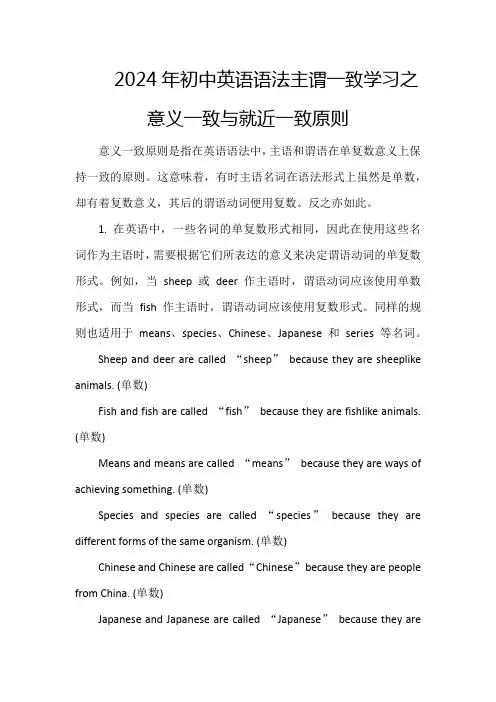
2024年初中英语语法主谓一致学习之意义一致与就近一致原则意义一致原则是指在英语语法中,主语和谓语在单复数意义上保持一致的原则。
这意味着,有时主语名词在语法形式上虽然是单数,却有着复数意义,其后的谓语动词便用复数。
反之亦如此。
1. 在英语中,一些名词的单复数形式相同,因此在使用这些名词作为主语时,需要根据它们所表达的意义来决定谓语动词的单复数形式。
例如,当sheep 或deer 作主语时,谓语动词应该使用单数形式,而当fish 作主语时,谓语动词应该使用复数形式。
同样的规则也适用于means、species、Chinese、Japanese 和series 等名词。
Sheep and deer are called “sheep”because they are sheeplike animals. (单数)Fish and fish are called “fish”because they are fishlike animals. (单数)Means and means are called “means”because they are ways of achieving something. (单数)Species and species are called “species”because they are different forms of the same organism. (单数)Chinese and Chinese are called “Chinese”because they are people from China. (单数)Japanese and Japanese are called “Japanese”because they arepeople from Japan. (单数)Series and series are called “series”because they are groups of related things. (复数)2. 使用“the”前缀时,需要根据形容词或名词的含义来确定谓语动词的单复数形式。
以教促考不同的人或物时,谓语动词用复数形式;当两个名词指相同的人或物时,谓语动词用单数形式。
例如:My best friend Linda and I both love acting and singing.我最好的朋友琳达和我都喜欢表演和唱歌。
The writer and teacher has been invited to make a speech about how to improve our study.这位作家兼老师应邀就如何提高我们的学习水平做了演讲。
当主语为集合名词时,如family,class,team,group,当这些集体名词指整体概念的时候,谓语动词用单数形式;当这些集体名词指具体成员的时候,谓语动词用复数形式。
例如:Our family has collected so many things over the years.我们家多年来收集了很多东西。
It’s9:00a.m.and Zhu Hui’s family are at home.现在是上午9点,朱辉的家人都在家里。
2.就近一致原则就近一致原则,就是谓语动词的数和靠近它的名词或代词在人称、数上保持一致。
具体如下:第一,由either...or...,neither...nor...和not only...but also...连接两个并列主语时,谓语动词和距离较近的主语在数上保持一致。
例如:Not only the students but also the teacher is coming to my birthday party.不仅学生,老师也将来参加我的生日聚会。
第二,There be...和Here be...这两个句式中,be动词常与离它最近的主语在数上保持一致。
例如:There are two trees and a garden in my grandmother’s yard.我奶奶的院子里有两棵树和一个花园。
主谓一致是指谓语动词与主语在人称和数上保持一致,主谓一致必须遵循三原则:语法一致原则,意义一致原则,就近一致原则。
对于主谓一致的考查,主要集中在单项选择、完形填空、汉译英及其它类型的填空题中。
在学习过程中,要掌握主谓一致的基本用法及常见搭配。
中考考查重点:主谓一致的三个原则:语法一致原则,意义一致原则,就近一致原则。
主谓一致是指谓语动词与主语在人称和数上保持一致,主谓一致必须遵循三原则:语法一致原则,意义一致原则,就近一致原则。
I. Multiple Choice1. We are proud of our country. The year 2019 is her __________ birthday.A. seventyB. the seventyC. seventieth2. Wu Dajing, a __________ Chinese skater, set a new world record at the Short Track World Cup last year.A. 25-years-oldB. 25 year oldC. 25-year-old3. September is the __________ month of a year.A. seventhB. eighthC. ninth4. We gave away __________ books to the school library last year.A. six thousandsB. six thousandC. six thousands of5. Every year, ___ books are given away to the poor children in the countryside.A. thousandB. thousands ofC. thousand of6. —Which month of the year do you like best?—July, the _______ month, because summer vacation begin in this month.A. sevenB. sixC. seventh7. —We’ll celebrate the _____ National Day this year.—That’s really exciting。
主谓一致三原则作者:刘平来源:《新高考·高一英语》2012年第05期主谓一致是高中阶段英语语法学习的重点之一。
学生在平时的学习过程中,尤其是在写作时,会忽视主谓一致的原则。
为更好地掌握主谓一致的使用原则,现将主要知识要点归纳如下:主谓一致是指句子的主语和谓语动词在人称和数上要保持一致,通常遵循以下三个原则:1. 语法一致原则,即主语是单数,谓语也要用单数形式;主语是复数,谓语也用复数形式。
2. 意义一致原则,即主语形式为单数,但意义是复数,谓语动词用复数;主语形式为复数,但意义为单数,谓语动词用单数。
3. 就近原则,即谓语动词的单复数形式由最靠近它的主语来决定。
一、语法一致原则1. 动词不定式、动名词或从句作主语时,谓语动词一般用单数。
what引导的主语从句,如果表语是复数,则谓语动词用复数形式。
例如:Seeing is believing. 眼见为实What he said is right. 他说的是对的。
What we need are more books. 我们需要的是更多的书。
2. 在定语从句中,关系代词that, which, who等作主语时,谓语动词的数应与句中先行词的数保持一致。
例如:I, who am your close friend, will help you. 我是你的好朋友,我会帮你的。
Those who want to go to the cinema puts up your hands. 想去电影院的人请举手。
Anyone who wants to go to the cinema puts up your hands. 谁想去电影院谁举手。
one of +复数名词+who/that/which”结构中,关系代词who/that/which的先行词是靠近它的复数名词,所以从句中谓语动词用复数形式。
但当one之前有the或the only 修饰时,关系代词的先行词是the one或the only one,因此从句中的谓语动词要用单数形式。
主谓一致常用的判断方法:1. 语法一致的原则;2. 意义一致的原则;3. 邻近一致的原则活学活用:谓语受主语支配,须和主语在人称和数上保持一致,这叫做主谓一致。
主谓一致一般遵循三条原则:语法一致原则,意义一致原则和就近一致原则。
1. 语法一致的原则(1)以单数名词或代词,动词不定式短语作主语时,谓语动词要用单数;主语为复数时,谓语用复数,例如:He goes to school early every morning.The children are playing outside.To work hard is necessary for a student.(2)由and或both……and连接的并列成分作主语时,谓语动词用复数。
例如:Both he and I are right.Mr Black and Mrs Black have a son called Tom.但并列主语如果指的是同一人,同一事物或同一概念,谓语动词用单数。
例如:His teacher and friend is a beautiful girl.The poet and writer has come.(3)由and连接的并列单数主语之前如果分别由each, every修饰时,其谓语动词要用单数形式。
例如:In our country every boy and every girl has the right to receive education.Each man and each woman is asked to help.(4)主语是单数时,尽管后面跟有 but ,except, besides, with 等介词短语,谓语动词仍用单数。
例如:The teacher with his students is going to visit the museum.Nobody but two boys was late for class.Bread and butter is a daily food in the west.(5)一些只有复数形式的名词,如people, police, cattle, clothes等作主语时,谓语动词要用复数。
名词的主谓一致规则
名词的主谓一致规则主要涉及三方面原则:语法一致原则、意义一致原则和就近一致原则。
语法一致原则:主语和谓语在语法形式上取得一致,即主语是单数形式,谓语也采取单数形式;主语是复数形式,谓语亦采取复数形式。
意义一致原则:谓语动词要和主语意义上的单复数保持一致。
例如,某些集体名词如team、family等作主语时,如果作为一个整体看待,谓语动词用单数形式;如果就其中一个个成员而言,谓语动词用复数形式。
就近一致原则:当连词or、not...but...、either ...or ...、neither ...nor ...、not only ...but (also) ...等连接两个名词或代词作主语时,谓语动词的形式一般与最靠近的词语保持一致。
此外,还有一些特殊情况需要注意:
代词each以及由every、some、no、any等构成的复合代词作主语时,谓语需用单数。
但each若放在主语后作同位语时,谓语动词用复数形式。
many a或more than one所修饰的短语作主语时,谓语动词多用单数形式。
不可数名词作主语时,谓语动词用单数形式。
并列结构作主语时,需要根据并列项的实际情况选择适当的谓语动词形式。
以上规则需根据实际情况灵活运用,以确保主谓一致。
主谓一致逻辑意义一致原则一.主谓一致的种类1 •语法形式上的一致主语为单数形式,谓语动词用单数形式;主语为复数形式,谓语动词也用复数形式。
如:The nu mber of the stude nts prese nt is 200.Jane and Mary look alike.2 •意义上一致1) 主语形式虽为单数,但意义为复数,谓语动词用复数。
如:The crowd were shouti ng.单数形式代表复数内容的词有:people, , cattle等。
2) 主语形式为复数,而意义上却是单数,谓语动词用单数。
女口:The news was so surpris ing.形复意单的单词有news和一些以ics结尾的学科名称,如physics,politics, econo mics 等。
3. 就近原则即谓语动词的单、复数形式取决于最靠近它的词语。
如用连词or, either -or, neither…not,ot only…butalso等连接的并列主语,如果一个是单数,一个是复数,谓语动词与靠近它的主语一致。
如:Either your stude nts or Mr. Wang knows this.二、逻辑意义一致原则逻辑意义一致就是谓语动词的数必须和主语的意义一致(因有时主语形式为单数,但意义为复数;有时形式为复数,但意义为单数)。
1. what,who,which,any,more, all等代词可以是单数,也可是复数,主要靠意思来决定。
如:Which ____ (be) your bag? / Which ____ (be) your bags?All _____ (be) going well. / All _____ (be) gone to Beijing.a. I know that all ___ gett ing on well with her.A. wereB. areC. isD. wasb. The boy sitti ng by the win dow is the only one of the stude nts who ___ from the coun tryside in our school.A. wasB. wereC. isD. are2. 表示时间、重量、长度、价值”等的名词的复数作主语时,谓语动词通常用单数形式,这是由于作主语的名词在概念上是一个整体,如:Thirty minutes is eno ugh for the worka. Twenty miles ____ a long way to cover.A. seem to beB. isC. areD. wereb. Ten thousa nd dollars ___ quite a large sum.A.areB. isC. wereD. have3. 若英语是书名、片名、格言、剧名、报名、国名等的复数形式,其谓语动词通常用单数形式。
如:“The Arabian Nights ” is an interesting^SOok*a. The Arabia n Nights __ w ell known to En glish lovers.A. is beingB. areC. wereD. isb. The Uni ted Natio ns __ i n 1945.A. was foundB. was foun dedC. were foun dedD. were foundc. Stories of the Long March ______ popular with the young people now.A. isB. wasC. areD. were4. 表示数量的one and a half后,名词要用复数形式,但是其短语作主语时,谓语动词用单数形式,例如:One and a half bananas is left o n the table.a. One and a half apples ___ o n the table.A. are leftB. is leftC. have leftD. has left5. 算式中表示数目(字)的主语通常作单数看待,其谓语动词采用单数形式。
女口:Twelve plus eight is twenty. / Fifty-six divided by eight is seven.a. Ni ne plus three ____ twelve.A. are mak ingB. is mak ingC. makeD. makes6. 一些学科名词是以-cs 结尾,女口:mathematics, politics,physics 以及news,works等,都属于形式上是复数的名词,实际意义为单数名词,它们作主语时,其谓语动词要用单数形式。
如:The paper works was built in 1990.a. Politics ___ o ne of the subjects that I study.A. areB. isC. wereD. wasb. Mathematics ______ the Ian guage of scie nee.A. areB. are going to beC. isD. is to be7. trousers glasses clothes,shoes 等词作主语时,谓语用复数,但如果这些名词前有a (the) pair of等量词修饰时,谓语动词用单数。
如:The pair of shoes un der the bed is his.a. This pair of trouseis ___ t oo long for him.A.isB.beC.areD.wereb. My glasses _ brokenA.isB. areC. beingD. has being8. 定冠词the +形容词或分词”,表示某一类人时,动词用复数。
a. The poor ___ in an undeveleped countryA. liveB. livedC. livesD. livi ngb. The blind ___ in special schools.A. studyB. studiesC. study ingD. studied练习:1.1 think physics ___ easy to study.A. is n 'B. aren'tC. wasD. had bee n2. The old ____ well looked after by the gover nment in Chi na.A. isB. areC. has bee nD. was3. Your trousers ___ dirty you must have _____ washed.A. is; itB. are; itC. are; themD. is; them4. “ The Kites ” ______ us a story of the kites history.A. have toldB. tellsC. were toldD. was told5. _____________ T hose who in compositi ons please hand them in this after noon.A. has n't han ded; hisB. have n't han ded; theirC.has han ded; theirD. have han ded; his6. This pair of shoes ____ m ade in Nanjing.A.isB. areC. have bee nD. had bee n7. Eight times eight ____ s ixty - four.A.isB.areC.getD.equal8. The United States of America _____ one of the most developed countries in the world.A. isB. areC. wasD. were9. His "Selected Poems" ____ first published in 1965.A.wereB. wasC. has bee nD. are10. All but one ____ h ere just now.A. isB. wasC. has bee nD. were11. The rich ___ not always happy.A.areB.isC.hasD.have12. The pair of shoes ____ worn out.。